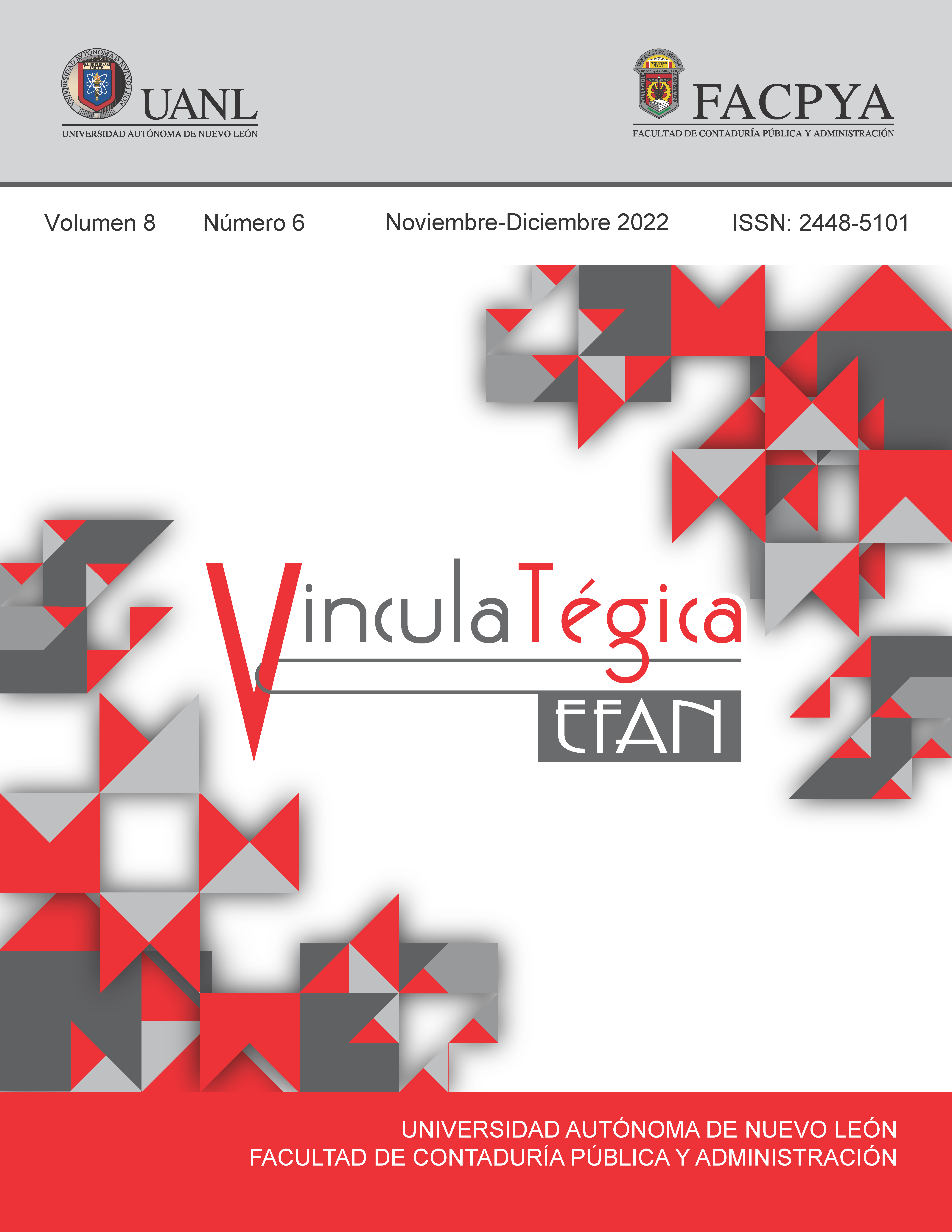El trabajo en equipo en el aula virtual universitaria: una experiencia educativa destacable y favorable
DOI:
https://doi.org/10.29105/vtga8.6-368Keywords:
trabajo en equipo en el aula virtual, aprendizaje basado en el equipo, estudio cualitativo, comunicaciónAbstract
Las instituciones universitarias en respuesta a los efectos de la pandemia del coronavirus requirieron al trabajo virtual para continuar ofreciendo su oferta educativa. En este trabajo se presenta una experiencia de trabajo en equipo virtual desde una perspectiva cualitativa-inductiva. Tomando como base una experiencia presencial de trabajar en equipo basada en el team-based learning (Michaelsen, Knight y Fink, 2004) por los autores de este estudio, se llevó a cabo una adaptación para trabajar en el aula de manera virtual. Mediante una revisión de literatura, se conformó el marco teórico. Se describió claramente la metodología utilizada. Los resultados obtenidos apoyan la implementación exitosa de esta experiencia, en la que, definitivamente, los aspectos positivos mencionados por los estudiantes superan a las barreras que ellos mismos señalaron. La conclusión es que el trabajo en equipo en el aula virtual es posible. Esperando más investigación al respecto para proponer su utilización en gran escala.
Downloads
References
Andres, H. P., & Shipps, B. P. (2010). Team learning in technology-mediated distributed teams. Journal of information systems education, 21(2), 213.
Bandura, A. (1977). Social learning theory. New York: General Learning Press.
Barrett, F. J., Thomas, G. F., & Hocevar, S. P. (1995). The central role of discourse in large-scale change: A social construction perspective. The Journal of Applied Behavioral Science, 31(3), 352-372. DOI: https://doi.org/10.1177/0021886395313007
Beer, M., Slack, F., & Armitt, G. (2005). Collaboration and teamwork: Immersion and presence in an online learning environment. Information Systems Frontiers, 7(1), 27-37. DOI: https://doi.org/10.1007/s10796-005-5336-9
Bower, M. (2011). Synchronous collaboration competencies in web‐conferencing environments–their impact on the learning process. Distance Education, 32(1), 63-83. DOI: https://doi.org/10.1080/01587919.2011.565502
Brame, C. J. (2013). Team-based learning. Vanderbilt University Center for Teaching. Retrieved [todaysdate] from https://cft.vanderbilt.edu/guides-sub-pages/team-based-learning/.
Bruner, J. (1996). The culture of education. Cambridge, MA: Harvard University Press. DOI: https://doi.org/10.4159/9780674251083
Chamakiotis, P., Dekoninck, E. A., & Panteli, N. (2013). Factors influencing creativity in virtual design teams: An interplay between technology, teams and individuals. Creativity and Innovation Management, 22(3), 265-279. DOI: https://doi.org/10.1111/caim.12039
Chen, M., Ni, C., Hu, Y., Wang, M., Liu, L., Ji, X., ... & Wang, X. (2018). Meta-analysis on the effectiveness of team-based learning on medical education in China. BMC medical education, 18(1), 1-11. DOI: https://doi.org/10.1186/s12909-018-1179-1
Edmondson, A. (1999). Psychological safety and learning behavior in work teams. Administrative science quarterly, 44(2), 350-383. DOI: https://doi.org/10.2307/2666999
Faja, S. (2013). Collaborative learning in online courses: Exploring students perceptions. Information Systems Education Journal, 11(3), 42.
Fulk, J. (1993) Social construction of communication technology. Academy of Management Journal, 36: 921–950. DOI: https://doi.org/10.2307/256641
Gomez, E. A., Wu, D., & Passerini, K. (2010). Computer-supported team-based learning: The impact of motivation, enjoyment and team contributions on learning outcomes. Computers & Education, 55(1), 378-390. DOI: https://doi.org/10.1016/j.compedu.2010.02.003
Kalaian, S. A., Kasim, R. M., & Nims, J. K. (2018). Effectiveness of Small-Group Learning Pedagogies in Engineering and Technology Education: A Meta-Analysis. Journal of Technology Education, 29(2), 20-35. DOI: https://doi.org/10.21061/jte.v29i2.a.2
Ku, H. Y., Tseng, H. W., & Akarasriworn, C. (2013). Collaboration factors, teamwork satisfaction, and student attitudes toward online collaborative learning. Computers in human Behavior, 29(3), 922-929. DOI: https://doi.org/10.1016/j.chb.2012.12.019
Lipnack, J., & Stamps, J. (1997). Reaching across space, time, and organizations with technology.
Luna-Benoso, B., Martínez-Perales, J. C., & Cortés-Galicia, J. (2021). The Skills and Use of Technologies in the Home Office in Times of Pandemic. DOI: https://doi.org/10.12988/ces.2021.91783
Michaelsen, L. K., & Sweet, M. (2011). Team-based learning. New directions for teaching and learning, 128(128), 41-51. DOI: https://doi.org/10.1002/tl.467
Michaelsen, L. K., Knight, A. B., & Fink, L. D. (2004). Team-based learning: A transformative use of small groups in college teaching.
Miranda, S. M., & Saunders, C. S. (2003). The social construction of meaning: An alternative perspective on information sharing. Information systems research, 14(1), 87-106. DOI: https://doi.org/10.1287/isre.14.1.87.14765
Painter, B., Posey, P. A., D Tenkasi, R. V., Barrett, B., & Merck, B. (2016). Sociotechnical systems design for coordination of virtual teamwork. Co-creating Humane and Innovative Organizations: Evolutions in the practice of socio-technical system design. Global STS-D Network/Creative Space (August 30, 2016), 123-144. DOI: https://doi.org/10.1108/TPM-12-2015-0060
Piaget, J. (1970). The science of education and the psychology of the child. NY: Grossman
Strauss, Anselm, and Juliet Corbin. (1998). "Basics of qualitative research techniques."
Swanson, E., McCulley, L. V., Osman, D. J., Scammacca Lewis, N., & Solis, M. (2019). The effect of team-based learning on content knowledge: A meta-analysis. Active learning in higher education, 20(1), 39-50. DOI: https://doi.org/10.1177/1469787417731201
Sweet, M., & Michaelsen, L. K. (2012). Team-based learning in the social sciences and humanities: Group work that works to generate critical thinking and engagement. Stylus Publishing, LLC.
Downloads
Published
How to Cite
Issue
Section
License
Copyright (c) 2022 Joel Mendoza Gómez, Esmeralda Guadalupe Rodríguez Pérez

This work is licensed under a Creative Commons Attribution 4.0 International License.
a). Authors keep copyright and give the journal the right of the first publication of the work under a Creative Commons attribution license. This license allows others to share the work as long as original authorship and initial publication in this journal is acknowledged.
b). Authors may make other independent and additional contractual agreements for the non-exclusive distribution of the version of the article published in this journal (e.g., include it in an institutional repository or publish it in a book) as long as they clearly indicate that the work was published for the first time in this journal.







